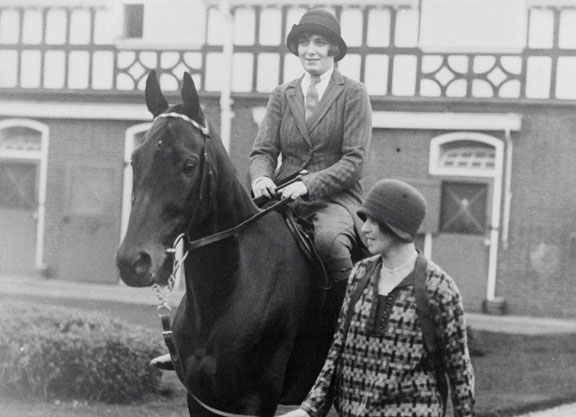By John Berry
The theory is that during the Christmas period one has some 'time off', whether that be a few hours or a few days. Eating and drinking traditionally become serious pastimes, and I always take the opportunity to do a bit of reading. This year I'll be buried primarily not in a book but in a wonderful treatise which I've just been given, the result of years of research by Jim Fuller.
Jim is Newmarket-born and -bred and, although he didn't follow his late father (who worked for Bernard van Cutsem in Stanley House) into the racing game, he loves Newmarket's racing heritage and now, in retirement, is a regular fixture during Tattersalls sales, manning the gateway connecting the main Park Paddocks complex with Terrace House.
Of all the aspects of Newmarket's history which Jim loves, its (and the world's) oldest race, the Town Plate, stands supreme. It is fair to say that he knows more about this historical oddity than any man alive.
It is not just that the Newmarket Town Plate, which is run every year over a three-and-three-quarter-mile course which starts on the National Stud and finishes along the July Course, pre-dates the internet or living memory; it pre-dates the span of most history books, having been inaugurated in 1666. Inevitably, many of the details of its past have been lost forever in the mists of time. But Jim has unearthed the results of 221 Town Plates, thus producing as comprehensive a list as is humanly possible. His detailed document makes riveting reading.
The first thing which strikes one is that, while King Charles II's name is forever linked with the race, he was not the only monarch who targeted it in its early years. King Charles II rode the Plate winner on October 14, 1671, bringing 'His Majesty's Horse' home in front of his three rivals. (He also won a Plate at Newmarket in 1675, seemingly riding a horse named Blue Capp). Later in the 17th century, King William III was the winning owner, when 'King William III's Horse' beat his only rival to land the Plate in on October 9, 1695. The identity of the winning rider is not recorded–but is it too hard to believe that it may have been the horse's owner, a thoroughly competent horseman who was both nephew and nephew-in-law of King Charles II?
The royal theme has continued much more recently when, in 2016, Qatar's Sheikh Fahad Al Thani won the 347th running of the Town Plate in his own colours aboard Almagest.
Another famous name to appear among the early Town Plate results is Sidney Godolphin, the First Earl of Godolphin who, as First Lord of the Treasury, was responsible for the creation of the United Kingdom, courtesy of the Act of Union (with Scotland) of 1707. He owned the winner of that year's Town Plate. Subsequently, his son Francis Godolphin, the Second Earl of Godolphin, made an even greater impact on turf history as owner of the breed-shaping stallion variously known as either the Godolphin Arabian or Godolphin Barb.
In the 20th century, the Town Plate became more notable for the women on its roll of honour than for the men. Until the 1970s the Jockey Club resisted the idea that women should be allowed to ride in races. However, the Town Plate was not run under Jockey Club rules (because it has its own rules and they pre-date the formation of the Jockey Club by the better part of a century). When the Plate was instituted in the 17th century it never occurred to anyone that ladies might want to ride in a race, so no one thought to insert a clause in the rules barring their participation. The only stipulation was that “no serving man or groom” might take part.
Consequently, women began to ride in the Town Plate decades before they were allowed to do so in more conventional races. On October 15, 1925 Miss Eileen Joel became the first woman to ride the winner of a race in Great Britain, winning the Town Plate on Hogier, owned by Mrs Walter Earl (and presumably trained by the owner's husband, although details of the winning trainer were not recorded). The following year's Plate was won by Staphania, owned by Mr H. A. Armitage, trained by Walter Griggs and ridden by Griggs' sister-in-law Miss Iris Rickaby–who subsequently became known formally as Mrs Keith Piggott and informally as 'Lester's mum' (and was thus mother-in-law of the winning rider of the 1963 Town Plate, which was won by Susan Piggott on board the John Benstead-trained Bingo).
Families have been a recurrent theme of the Town Plate. Eileen Joel's daughter Miss Valda Rogerson rode the winner (on Vulpes) 30 years after her mother's triumph; in turn her daughter Miss Alex Embiricos won the race in 1984, beating 18 rivals on her mother's Josh Gifford-trained Summons. Other members of Eileen Joel's family to ride the winner were her niece Solna Joel (in 1948, on her own horse Filius) and great-niece Miss Diana Thomson Jones, who won in 1964 on Stem Turn, owned by her grandfather Stanhope Joel and trained by her father Harry Thomson Jones.
More recently, the mighty Sea Buck provided a happy family story. On October 8, 1994 Carolyn Poland's Sea Buck, trained by her brother-in-law Henry Candy, won the race by a short head, ridden by his owner. Sea Buck then won the race again in each of the next four years, scoring under Mrs Poland's niece Sophie Candy in 1995 and '96 and under Sophie's sister Emma in both '97 and '98.
The Harwood family is another to have enjoyed success in the Town Plate. Guy Harwood trained the winner in both 1985 and '86, the first time with Velvet Touch ridden by one of his daughters (Amanda) and the second time with Bushido ridden by another (Gaye). The girls rode, incidentally, in famous colours: Velvet Touch was owned by Sheikh Mohammed and Bushido by Khalid Abdullah.
I have always described Sea Buck as the ultimate Town Plate horse, but Jim Fuller's research has shown that this is not the case. That honour is held (and almost certainly always will be held) by Prestonfield, winner of the race at least six times between 1899 and 1906. Jim has established that Prestonfield, who was owned by the Waugh family and appears listed variously under the ownership of the brothers Thomas, James and Robert Waugh, won the race in 1899, 1900, '03, '04, '05 and '06. It seems possible that he also won it in 1901 and '02, but Jim has been unable to find details of those races. In his first two wins he was ridden by Thomas Waugh; in his final four he was ridden by Mr F. A. Simpson, a notable Newmarket horseman who (like Prestonfield) set Town Plate records which are likely to stand forever.
Frank Simpson's Town Plate record is formidable: he rode the winner at least 16 times between 1903 and 1931. (I believe him to have ridden the winner 17 times, but only 16 appear on Jim's list–which leads me to hope that the seventeenth might have been the 1902 renewal on Prestonfield). Age did not weary Frank Simpson: he was aged 77 the final time he won the race (in 1931 on his own horse Bogus) and rode in the race again the following year, finishing second behind Mr Bertram, ridden by Audrey Bell.
Another prolific rider of the time was Mr C. W. Stevens, who won the race six times between 1910 and '18, on five different horses for four different owners. His final two victories, in 1917 and '18, came on board Green Falcon and Tweedledum, both owned and trained by the legendary Robert Sievier, who is best known for winning four of the five Classics in 1902 with his great filly Sceptre. Sievier, the only owner/trainer ever to be champion trainer, had prepared Sceptre at Shrewton in Wiltshire but during and immediately after the First World War he trained in Fitzroy House in Newmarket, now the base of Michael Bell.
I'm hoping perhaps eventually to create another Town Plate family story. I had the thrill in 2011 of collecting the traditional and highly-coveted prize (three dozen Newmarket sausages) as a result of winning the race as owner, trainer and rider with Kadouchski. Afterwards I formed a vague ambition to win it as owner, trainer, rider and breeder. That ambition, however, is almost certainly going to remain unfulfilled because, if I ever have another runner, I hope that my son Anthony, currently aged 16, might be in the saddle. I'd happily settle for making my way into Jim Fuller's records in the triple roles of owner, trainer and sire.
Not a subscriber? Click here to sign up for the daily PDF or alerts.






